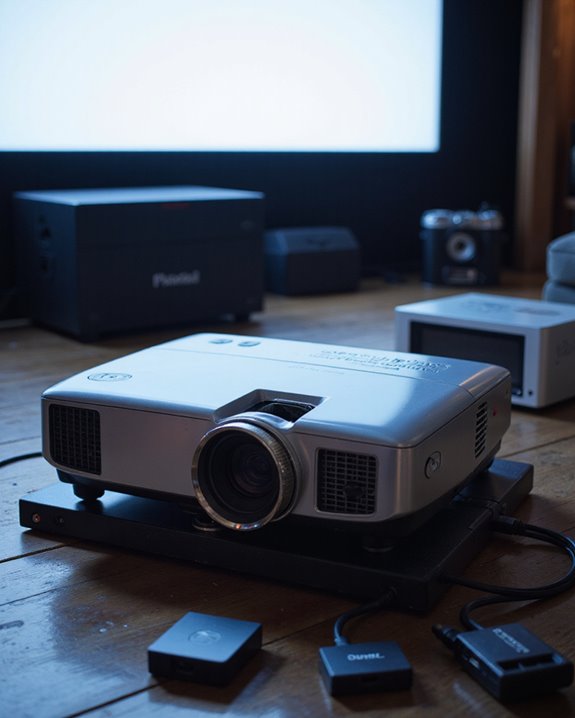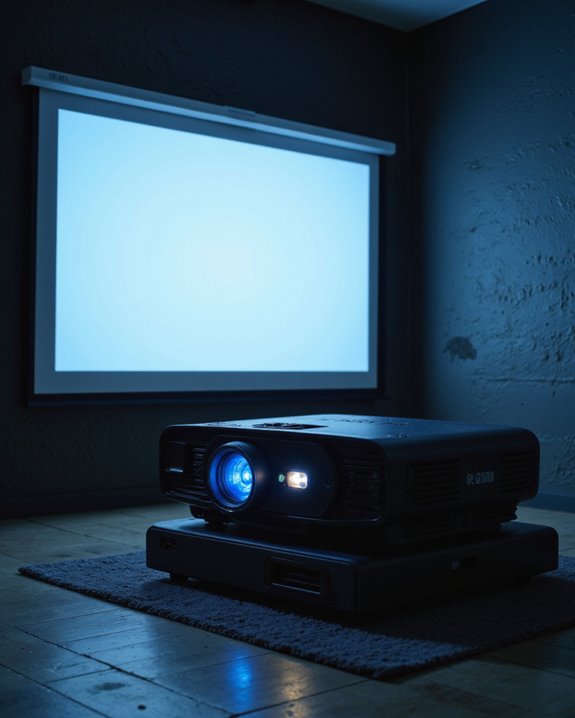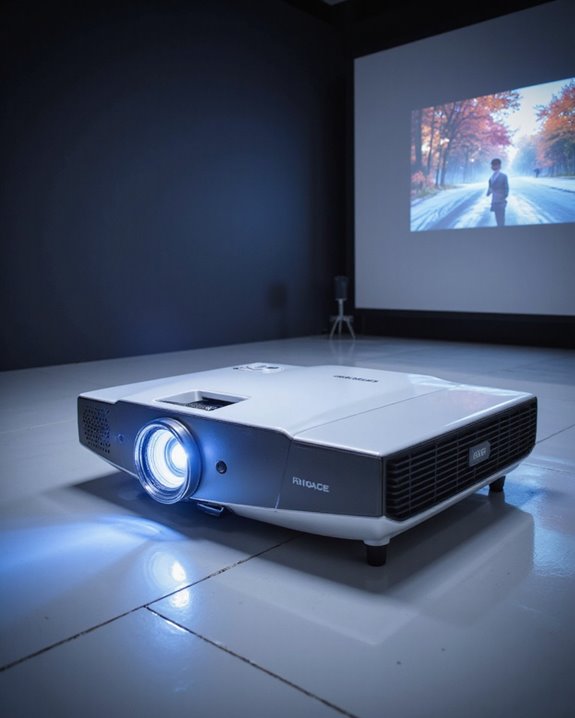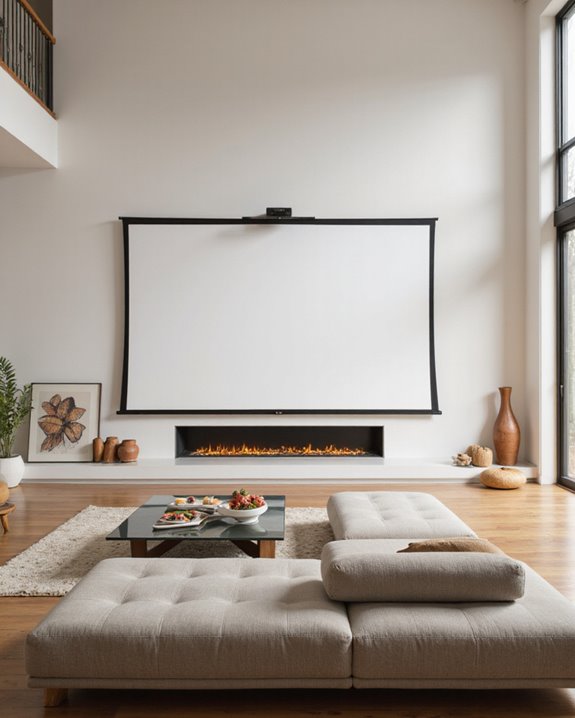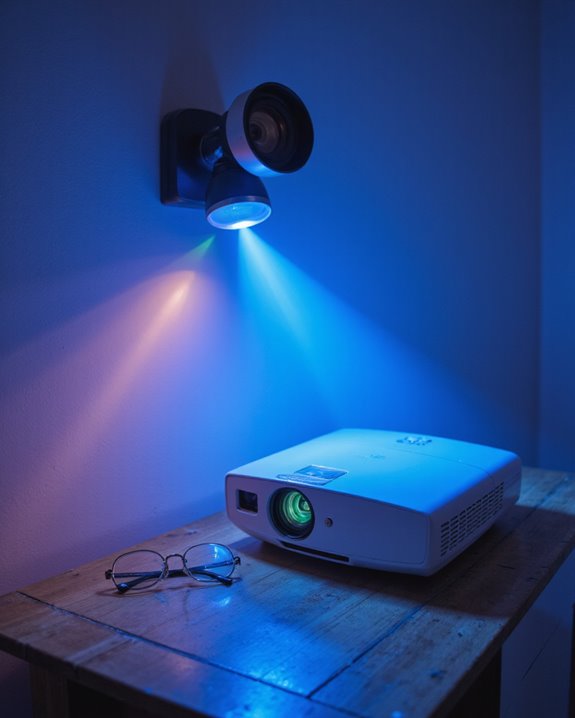Most modern projectors do not come with built-in TV tuners, though some specialized models include this feature. Viewers can access TV content through external devices like digital tuners, set-top boxes, or streaming sticks connected via HDMI ports. Select projector models from brands like LG, Samsung, and Hisense offer integrated tuners for direct broadcast reception. Alternative solutions include using network-based tuners or converter boxes, making TV viewing possible on virtually any projector through proper setup and equipment selection.
Key Takeaways
- Most modern projectors do not come with built-in TV tuners, requiring external devices for broadcast TV reception.
- Select models like LG PG65U and Samsung Premiere series include integrated TV tuners for direct broadcast reception.
- External digital TV tuners, converter boxes, or streaming devices can add TV functionality to any projector.
- Projectors can connect to TV signals through HDMI inputs using set-top boxes, satellite receivers, or streaming sticks.
- Network-based tuners like HDHomerun or IPTV services offer alternative methods for accessing TV content on projectors.
Understanding TV Tuners in Modern Projectors
A TV tuner serves as a critical component that enables projectors to receive and display television broadcast signals directly. This technology, which involves sophisticated signal processing capabilities, allows users to connect their projectors to antennas or cable systems for accessing broadcast channels without additional equipment. TV tuner integration can significantly enhance a projector’s versatility, especially for those seeking an all-in-one entertainment solution. For cord-cutters who have moved away from traditional cable subscriptions, antenna compatibility becomes particularly important. These viewers rely on over-the-air signals for their entertainment needs, making TV tuners an essential feature in their projection systems. Currently, a selection of nine TV tuner projectors is available in the market, with prices ranging from entry-level to premium options. However, it’s noteworthy that not all modern projectors come equipped with built-in TV tuners. This feature’s availability varies among different models and manufacturers, reflecting market trends driven by changing consumer viewing habits and the increasing demand for flexible entertainment options.
Benefits of Built-In TV Tuners for Home Entertainment

Built-in TV tuners transform modern projectors into all-encompassing entertainment hubs, delivering significant advantages for home viewing setups. These integrated systems offer remarkable content diversity through access to local broadcast channels without requiring additional equipment. Users benefit from streamlined operation through remote compatibility, allowing them to control all functions with a single device.
The economic advantages are *noteworthy*, as built-in tuners eliminate the need for separate devices while providing access to free over-the-air programming. The setup process becomes more straightforward, with fewer cables and connections to manage. Additionally, these projectors create an immersive viewing experience by combining large-screen capabilities with direct channel access. Regular signal checks and maintenance help ensure consistent performance and optimal viewing quality. Incorporating antenna compatibility can further enhance reception quality and channel variety. For homeowners seeking to maximize their entertainment value while minimizing complexity, projectors with built-in tuners represent a practical solution for modern viewing needs.
Popular Projector Models With Integrated TV Tuners

Modern projector manufacturers have integrated TV tuners into several popular models, offering consumers diverse options across different price points and feature sets. The LG PG65U portable LED projector stands out with its built-in digital TV tuner and remote compatibility features, making it ideal for versatile home entertainment setups. With its WXGA resolution capabilities, this projector delivers clear, detailed images perfect for both TV viewing and multimedia content. Additionally, some models incorporate antenna connectivity to facilitate easier access to local broadcast channels without additional equipment.
Samsung’s Premiere series, including the LSP7T and LSP9T models, delivers advanced screen calibration options alongside ultra-short throw capabilities. These projectors provide 4K resolution and smart connectivity features for enhanced viewing experiences. The Hisense L9H Laser TV takes integration further by combining a TV tuner with Google TV capabilities and Dolby Vision support.
For budget-conscious consumers, the Miroir M700S offers 1080p resolution with TV tuner functionality in a portable format, proving that quality features are available across various price points.
How to Set up a Projector With TV Tuner Capabilities

Setting up a projector with TV tuner capabilities requires careful planning and the right combination of equipment to achieve ideal viewing results. Since most projectors lack built-in tuners, users need to connect an external set-top box or TV tuner device through HDMI cables. Regular projector maintenance ensures excellent performance when viewing television content. Modern projectors can also utilize streaming TV sticks for accessing live television programming.
The setup process involves connecting the external tuner to both an antenna for local broadcasts and the projector itself. While wireless connectivity options exist for some modern devices, a hardwired HDMI connection typically provides the most reliable signal. Users should adjust their projector’s settings, including resolution and focus, to match the input source. Important considerations include:
- Proper cable connections
- Input source selection
- Ambient light control
- Audio system integration
Alternative Options for Watching TV Content on Projectors
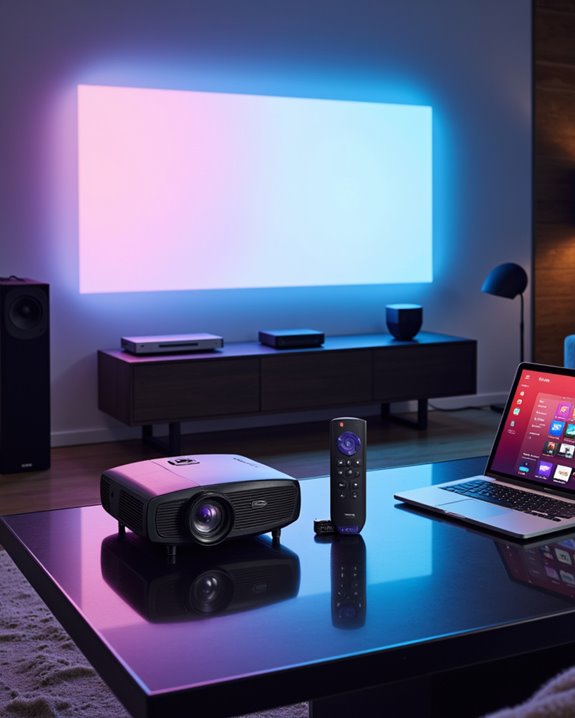
While most projectors lack built-in TV tuners, viewers have numerous alternatives for accessing television content through their projection systems. Modern solutions include external digital TV tuners, streaming devices, and network-based options that can transform any projector into a capable television display.
Even vintage projectors can be adapted for TV viewing through converter boxes and HDMI adapters. For those seeking satellite compatibility, external tuners can connect satellite receivers directly to projectors via HDMI or composite inputs. One popular option is the ADTB01F digital converter, which has garnered over 1,200 user reviews for its reliability in converting digital signals. Additional options include:
- Network TV tuners like HDHomerun for whole-home streaming
- Streaming devices such as Roku or Fire TV Stick
- Ultra-short throw laser TVs with built-in tuners
- IPTV services accessed through smart devices
- Digital TV converter boxes with DVR functionality
Each solution offers unique features and flexibility for different viewing preferences and setup requirements.
Best Practices for Optimal TV Viewing With Projectors
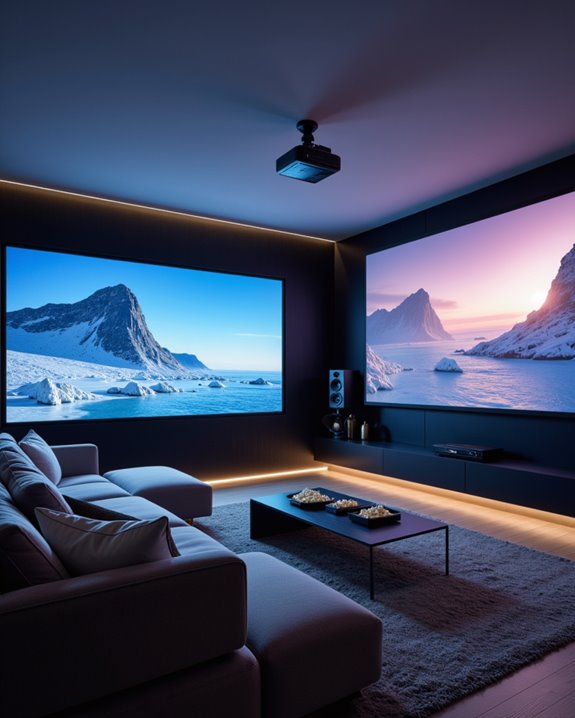
Achieving ideal TV viewing with a projector requires careful attention to several key technical and environmental factors. Regular projector lens maintenance ensures peak image clarity and brightness, while proper ambient light control through blackout curtains or controlled lighting enhances picture quality. High-performance projectors with at least 800 lumens are recommended for daytime viewing conditions.
For the best viewing experience, users should:
- Select appropriate picture modes designed for TV content
- Position the projector to avoid keystone distortion
- Clean projection surfaces regularly to prevent image degradation
- Connect external speakers for superior audio quality
The viewing environment plays an essential role in image quality. Proper screen distance, typically allowing for a 26-40 degree viewing angle, helps maintain comfortable viewing. Managing room lighting, particularly avoiding direct light on the screen surface, markedly improves contrast and color reproduction during TV watching sessions.
Frequently Asked Questions
Can Projectors With TV Tuners Work in Areas With Weak Broadcast Signals?
When push comes to shove, projectors with TV tuners can struggle in weak signal areas. Success depends heavily on signal strength and tuner compatibility, often requiring additional equipment like amplifiers for acceptable performance.
How Long Do TV Tuner Components Typically Last in Projectors?
TV tuner components typically maintain screen lifespan and component durability for 5-10 years, aligning with overall projector life. Performance may gradually decline before complete failure, depending on usage conditions and environmental factors.
Are Built-In TV Tuners More Energy-Efficient Than External TV Tuning Devices?
Like an ancient sundial’s efficiency, built-in TV tuners generally offer better energy savings than external devices. The consolidated system reduces overall power consumption by eliminating the need for separate power sources and duplicate components.
Can Projector TV Tuners Receive Both International and Local Broadcast Channels?
TV tuners’ capability to receive international and local broadcasts depends on broadcast standards compatibility. Screen calibration and sound compatibility may require adjustment when switching between different channel formats for ideal viewing experience.
Do Weather Conditions Affect the TV Signal Reception on Projector Tuners?
Like a temperamental symphony, weather conditions vital impact TV signal reception. Rain, snow, and storms can cause signal interference, while proper antenna placement becomes essential for maintaining clear reception during adverse atmospheric conditions.

